Sabbath Silver
Holy Books from the Collection of Bernard van Noordwijk
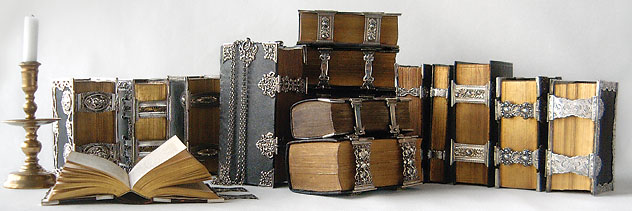
In an era when leather bindings on books are considered a
luxury, it is easy to forget that for most of the book’s 2,000-year history, almost all
volumes were bound in calf skin or sheepskin. For centuries, book owners
desiring something more lavish than utilitarian
leather commissioned elaborate designs to be worked into the cover, or decorations of jewels or ivory. The most ornate treatments were
reserved for Bibles and other holy books owned
by the church or nobles. In the seventeenth century, ornate silver
decorations became affordable to and popular among the burgeoning middle
class of successful merchants and lesser nobles. These bindings indicated the importance of the books, the
wealth of their owners, or both at the same
time. For nearly two centuries, books adorned with silver were popular in
Western Europe.
Bernard van Noordwijk, a retired Dutch management
consultant, has assembled an extensive
collection of books with silver adornments. He is interested in small volumes of religious texts such as
prayer books, missals, and hymnbooks, the sort of book that someone,
usually a woman, would have carried to church. The books themselves—standard religious texts in most
cases—are often not particularly valuable. European printers
manufactured them in vast quantities, and they can be found in any good
antiquarian shop. The silverwork on the bindings, however, makes them
special as objects and as a record of European church fashions from the
seventeenth through the nineteenth centuries. They were bound and adorned
centuries after books no longer needed to be chained to shelves for
safekeeping, yet some of them incorporate chains into their design. The
silver chains may have even allowed their owners to carry them like
handbags. The books
were anachronisms and impractical in one key respect: The metalwork prevented them
from being stored with other books. Pulling them on and off the shelf would
scratch and tear the covers of the adjacent volumes. Van Noordwijk believes
the books were typically displayed on a mantelpiece when not in use.
While books adorned with silver were probably fairly
common at one time, most of them have been disassembled because the silver
is worth more than the book. In fact, that’s how van Noordwijk
started collecting these books. Thirty-five years ago, he noticed that one of his
wife’s silver bracelets appeared to be fashioned from a book clasp.
Early binders mounted brass clasps or affixed leather ties to the edges of
books to hold them closed when they weren’t in use. Before bookcases
came into widespread use, books were often
stored flat on a shelf or locked in a trunk. With time and use, the pages
tended to warp slightly, preventing the covers from closing tightly.
Eventually, this would damage the book and make it susceptible to dust and
insect pests. The solution was to clamp or tie the book closed when it
wasn’t in use. Before he realized that his wife’s bracelet had
once been part of a book, van Noordwijk had
never paid much attention to books with clasps fashioned from silver.
As often happens with collectors, once he knew what he
was looking for, van Noordwijk soon spotted other books with ornamental
silverwork still attached. The first example he found seemed too expensive, and he
didn’t buy it. He continued to think about it, however, and
eventually returned prepared to pay the asking price. The book was gone,
sold to have its clasps made into knife rests, according to the shopkeeper.
Thus began three decades of collecting to save silver-adorned bindings from
being converted into jewelry or dining room accessories. The books, valued
mostly for their silver content, typically cost a few hundred to a few
thousand dollars. Van Noordwijk’s efforts to preserve these
endangered books will culminate in a February through June exhibition of
his books at the Bijbels Museum (Bible Museum) in Amsterdam, where he is a
guest curator. The
examples that follow will be depicted, with many other books from his
collection, in the illustrated exhibition catalog, which will provide the
most extensive documentation of silver-adorned bindings to date.



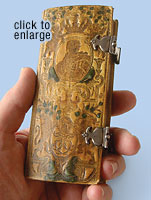
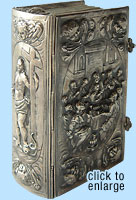

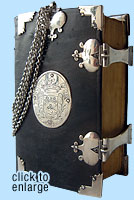
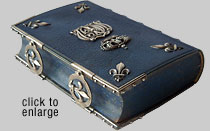 appears at the corners and on the clasps and enhances the religious symbolism of the binding materials.
appears at the corners and on the clasps and enhances the religious symbolism of the binding materials.